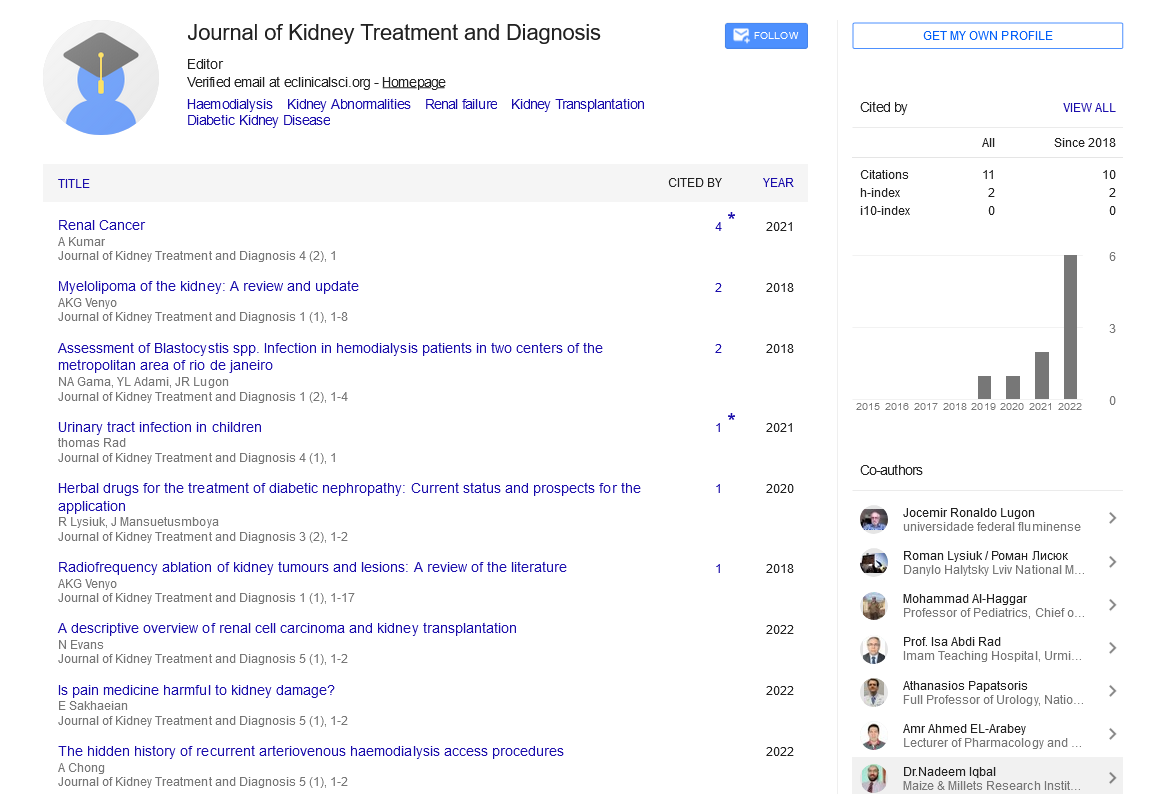Addictive drugs and kidney toxicity
Received: 21-Feb-2023, Manuscript No. PULJKTD-23-6180; Editor assigned: 24-Feb-2023, Pre QC No. PULJKTD-23-6180 (PQ); Reviewed: 14-Mar-2023 QC No. PULJKTD-23-6180; Revised: 25-Apr-2023, Manuscript No. PULJKTD-23-6180 (R); Published: 03-May-2023
Citation: Johnston E, Friis T. Addictive drugs and kidney toxicity. J Kidney Treat Diagn 2023;6(1):1.
This open-access article is distributed under the terms of the Creative Commons Attribution Non-Commercial License (CC BY-NC) (http://creativecommons.org/licenses/by-nc/4.0/), which permits reuse, distribution and reproduction of the article, provided that the original work is properly cited and the reuse is restricted to noncommercial purposes. For commercial reuse, contact reprints@pulsus.com
Abstract
Abuse related drug use is on the rise, which is worrying for global public health. Given that these organs are involved in their filtration, concentration and conversion to potentially harmful metabolites, they are particularly susceptible to the toxicity of these compounds. Several substances of abuse have been associated with various clinical symptoms that are known to presage acute and chronic kidney impairment, such as rhabdomyolysis, vasoconstriction, and decreased estimated glomerular filtration rate (e.g., cannabinoids, cocaine, opioids, substituted phenethylamines). The fundamental mechanisms, however, are still not well known.
Keywords
Cannabinoids; Cocaine; Opioids; Metabolites; Rhabdomyolysis
Description
Almost 269 million people used drugs of abuse in 2018, which is an increase from previous years. This constitutes a problem for global public health. Controlling this drug abuse has become a concern for researchers and policy-makers as these numbers are expected to reach close to 300 million by 2030. Substances of abuse, such as cannabis, cocaine, opioids, and substituted phenethylamines, primarily affect the brain and have psychotropic effects. These effects are frequently linked to negative effects on neurons (e.g., impaired memory and cognition, psychosis, anxiety). Yet, their toxic effects frequently spread to other organs, such as the kidneys, which are in charge of filtering, concentrating, and partially metabolizing these compounds to metabolites that may be harmful.
Abuse related drugs have reportedly been linked to renal side effects, such as Acute Tubular Necrosis (ATN), obstructive nephropathy or hyponatremia. There are three basic mechanisms through which drugs of abuse related nephrotoxicity may manifest:
• Apical exposure to drugs and/or their metabolites, apical uptake of
these drugs and metabolites, or drug/metabolite secretion from the
basolateral surface into the tubular lumen, which results in proximal
tubular injury and ATN.
• Tubular obstruction brought on by the formation of crystals containing
drugs and their metabolites.
• Interstitial nephritis brought on by drugs and their metabolites.
At the kidney level, these pathways are frequently linked to a variety of unique clinical presentations. For instance, prolonged immobility (such as from painkillers) or muscular breakdown from effort can both result in rhabdomyolysis, which frequently results in AKI (e.g., synthetic cannabinoids, ecstasy, synthetic cathinones). Cocaine and methamphetamine users frequently exhibit generalized vasoconstriction and ischemia kidney damage brought on by an increase in sympathomimetic activity. A thrombotic microangiopathy may also be brought on by more recent opioids and amphetamines. Certain drugs, like heroin, may also directly harm the kidneys by encouraging the deposition of amyloid and glomerular immunoglobulin.
Some compounds have different levels of nephrotoxicity depending on factors including their inherent nephrotoxic potential, whether the patient is more likely to suffer kidney damage, or how the kidney processes the material. Abuse of the substances discussed here frequently leads to clinical signs and symptoms (such as rhabdomyolysis, dehydration, vasoconstriction, and a reduced estimated glomerular filtration rate) that are known to precede acute and chronic kidney impairment. Although the capacity of some illicit drugs to cause kidney damage has been well established (such as heroin and cocaine), the molecular mechanisms underlying these drugs' nephrotoxicity are typically still understudied.
The activation of pro apoptotic signaling pathways in response to the impairment of mitochondrial function (e.g., synthetic cannabinoids), the pro oxidant and/or pro-inflammatory activities of some drugs of abuse and their metabolites (e.g., tobacco), or the activation of the renin angiotensin system (e.g., cocaine, nicotine) have however emerged as important contributors to the onset of kidney damage. Even though significant renal adverse effects have been seen after cannabis use, an association between its usage and kidney damage has not yet been proven.





